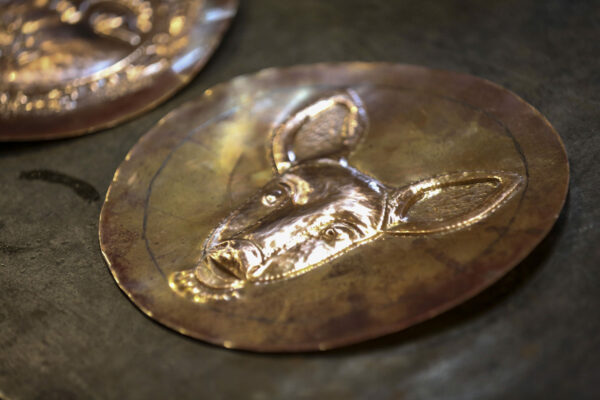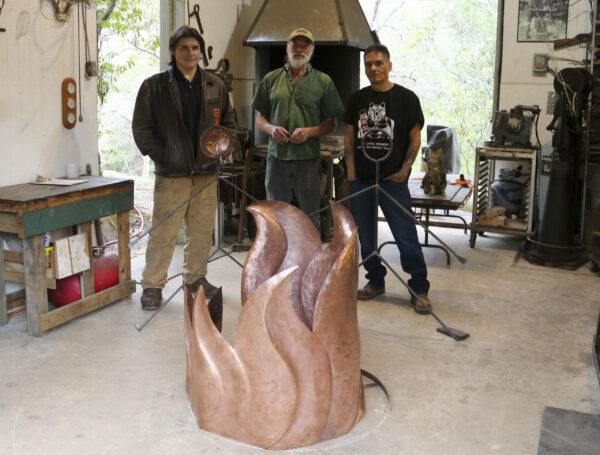
Nathan Bush, William Rogers, and James “JR” Wolfe stand in front of the flame portion of the piece they’re currently working on, representing the Cherokee clans, that will be installed in a courtyard at the Cherokee Indian Hospital. (SCOTT MCKIE B.P./One Feather photos)
By SCOTT MCKIE B.P.
One Feather Asst. Editor
CULLOWHEE, N.C. – Up a winding mountain road by a beautiful stream, just past the campus of Western Carolina University, is a metalworking shop where three men are practicing an art that has been done by Cherokee people in these mountains for thousands of years. The shop belongs to William Rogers, a master craftsman, who, for several years, has been mentoring Nathan Bush and James “JR” Wolfe, both members of the Eastern Band of Cherokee Indians (EBCI).
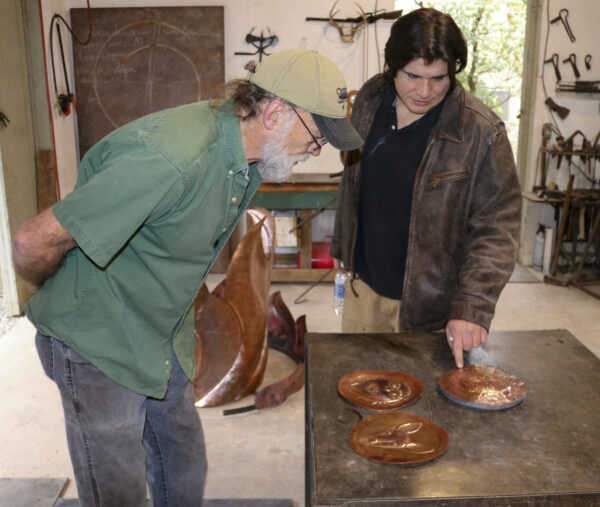
William Rogers, master craftman, and Nathan Bush, an EBCI tribal member from the Snowbird Community, look at a detail of one of the copper Cherokee Clan Masks they’ve created for their most recent sculpture.
The trio, who work together as great friends, is currently working on a piece, commissioned by the Cherokee Indian Hospital Foundation through a grant from the Cherokee Preservation Foundation, that will feature masks of the seven Cherokee Clans surrounding a fire. This current work will be their third large copper sculpture that can be seen in western North Carolina including a piece at the Stecoah Valley Cultural Arts Center representing the Cherokee Eternal Flame and one at the Cherokee Indian Hospital entitled “Grandfather Buzzard” that flies above the hospital’s river walk area. To date, the men have put in over 400 hours on their current project.
“The Native Americans would use copper right out of the ground. So, they would hammer it to that shape. We’re lucky. We get to go buy a piece,” said Rogers. “They used it in an historical sense because their history was verbal and the storytelling was a very important part.”
“Copper work has been done for a very long time. 5000 BC I think was when they were making garden tools out of copper in Ohio and all down the Ohio River Valley.”
But, it was a lost art for a long time.
Rogers noted, “When I moved to this area, I was always disappointed to hear people say ‘Native Americans didn’t do metal’. From my research in history, I knew that wasn’t true. When we started this project, I did some research on all the conquistadors, English and Spanish, that hit the east coast – almost every one of them said Native Americans were working copper. For that kind of information to be kind of tucked away and not presented to the public was something I really felt was important to change.”
Rogers was awarded an Individual Artist Fellowship by the Tennessee Arts Commission in 1984 and was named a master craftsman in Virginia in 2002. Several years ago, he received a Folklife Apprenticeship grant from the N.C. Arts Council that allowed him to mentor Bush and Wolfe to teach and share hammered copper and blacksmithing skills. Information from the Arts Council states, “Rogers, Bush, and Wolfe are working to revive Cherokee metalsmithing knowledge and practice, and to make it ‘come alive again’ in Cherokee’s schools and craft centers like the Oconaluftee Indian Village.”
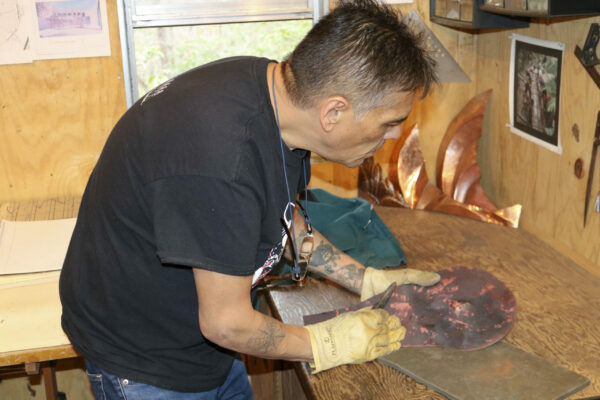
James “JR” Wolfe, an EBCI tribal member from the Big Cove Community, works on a piece using the repousee’ technique – referring to forming a design by hammering or pushing from the back of the piece.
The late Arch Miller, a Cherokee Nation citizen who was a member of the Qualla Arts and Crafts Mutual, Inc., was the last known metalsmith in Cherokee and a man Rogers has studied. According to information from Western Carolina University, “Miller worked at his craft part-time, during off hours from his job at the (Cherokee Indian) hospital. His metal shop was located in the Yellowhill Community on the Qualla Boundary, where he produced work in both iron and copper. He made a variety of tools, kitchen implements, and decorative items.”
Wolfe, from the Big Cove Community, is excited to be a part of this rejuvenation and credits Rogers with getting the ball rolling. “This is indispensable knowledge that was actually lost. So, me and Nathan, as well as people on the (Qualla) Boundary, we owe a real great debt to this man (Rogers). Nobody would probably even remember Arch Miller.”
A part of the current grant allows the men to visit the various community clubs of the EBCI teaching and sharing their art – something all three feel is very important.
Wolfe, who is pursuing an associate’s degree in fine arts, said, “Being an artist, you’re always going to be a student of art. You just have to keep your mind open to learning. The best thing about it is that knowledge can give a lot back to the community. It’s helped me.”
Bush, program coordinator at the Oconaluftee Indian Village, noted, “I got into it more to teach it… A lot of this copper work got lost during the Trail of Tears days, like a lot of traditions did. Then, Arch Miller came around and did it as a hobby…I didn’t even know we even did copper or that it was even a Native thing. Then, to find out that Arch Miller was one of the last ones in Cherokee to do it really inspired me to pick it up and keep doing it – especially to teach it. It’s good to teach this to Natives, especially.”
He said he hopes their work inspires others. “I get happier teaching it. When I was growing up, my family taught you plants. We didn’t learn crafts, but they taught us plants and medicine. They get empowered when they teach you this stuff when you’re a kid. I got that same feeling as those adults did when they were teaching me. This is a dead tradition but it’s coming back alive. Hopefully some of the kids will want to do it again.”
The artistry of the craft is also important to them. Rogers said, “I think it’s very valuable to have contemporary art. The history part is valuable because you’re studying artists before you. But, to have that contemporary reflection of history is even better because then it has more continuity as it goes forward just like any verbal history.”
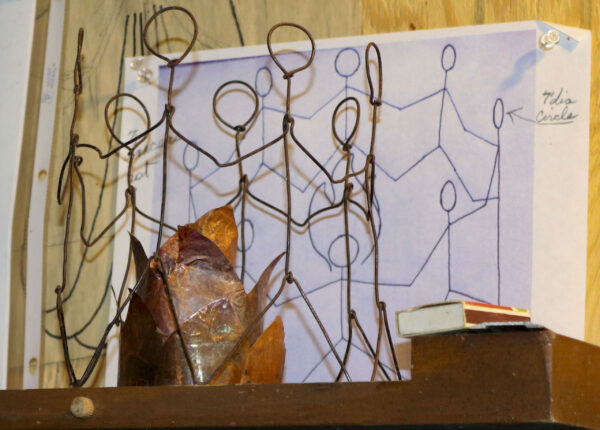
The photo shows a small-scale conception of the sculpture the trio is currently working on for the Cherokee Indian Hospital Foundation.
Wolfe said, “I just love doing this work. For me, it’s like clay.”
He thinks about continuing the work done by Cherokee people for thousands of years. “It’s really significant to me. It puts us in really good company. As people that are preserving the history, to me, it’s awesome and it’s a learning experience. This is something that’s worth passing down. I passed it down to my son.”
Bush said his favorite part is being around Rogers and Wolfe and said the entire experience has opened up his artistic side. “Before I started taking his (Rogers) class, I didn’t do art at all. I couldn’t draw or do anything artistic. Then, after working at the Oconaluftee Indian Village and being around all that art I got inspired by a lot of the workers up there.”
He summed up the enthusiasm in the shop best by saying, “I like all of it, but doing big projects like this are exciting.”
The enthusiasm is spreading. Bush noted that a few years ago copper work was added to the Cherokee Indian Fair exhibit contest as an entry for the first time in 100 years and is now officially a category going forward.
